CHCECE004: Promote and Provide Healthy Food and Drinks - Knowledge
VerifiedAdded on 2023/06/15
|24
|4384
|362
Homework Assignment
AI Summary
This assignment focuses on promoting and providing healthy food and drinks in early childhood education, aligning with CHCECE004 standards. It covers preparing and heating infant formula, emphasizing hygiene and safety. It highlights the importance of nutritious food for children's growth and development, referencing the National Quality Standard (NQS) and Australian Dietary Guidelines. The assignment details regulations for food provision in childcare services, including dietary requirements and weekly menu planning. It discusses the significance of dietary fats, the introduction of solids, and age-appropriate food types. Further, it emphasizes the role of educators in encouraging healthy eating habits, meeting daily nutritional requirements, and maintaining safe food practices. The document also provides guidance on packing healthy lunchboxes, reading food labels, and managing special dietary needs, including a section on mealtime and safe food handling practices. It concludes by addressing the responsibilities of childcare centers in menu planning and ensuring children develop positive attitudes towards food.
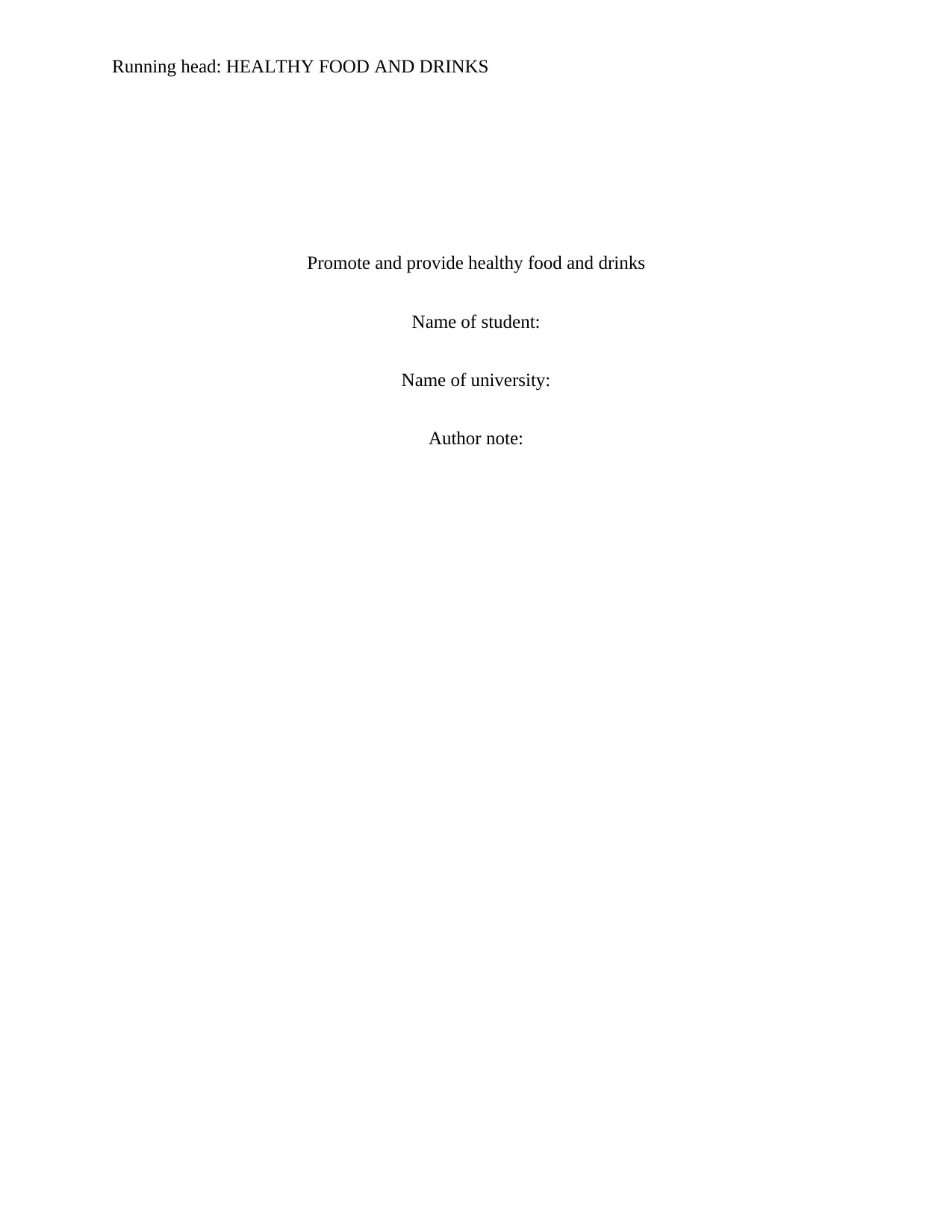
Running head: HEALTHY FOOD AND DRINKS
Promote and provide healthy food and drinks
Name of student:
Name of university:
Author note:
Promote and provide healthy food and drinks
Name of student:
Name of university:
Author note:
Paraphrase This Document
Need a fresh take? Get an instant paraphrase of this document with our AI Paraphraser
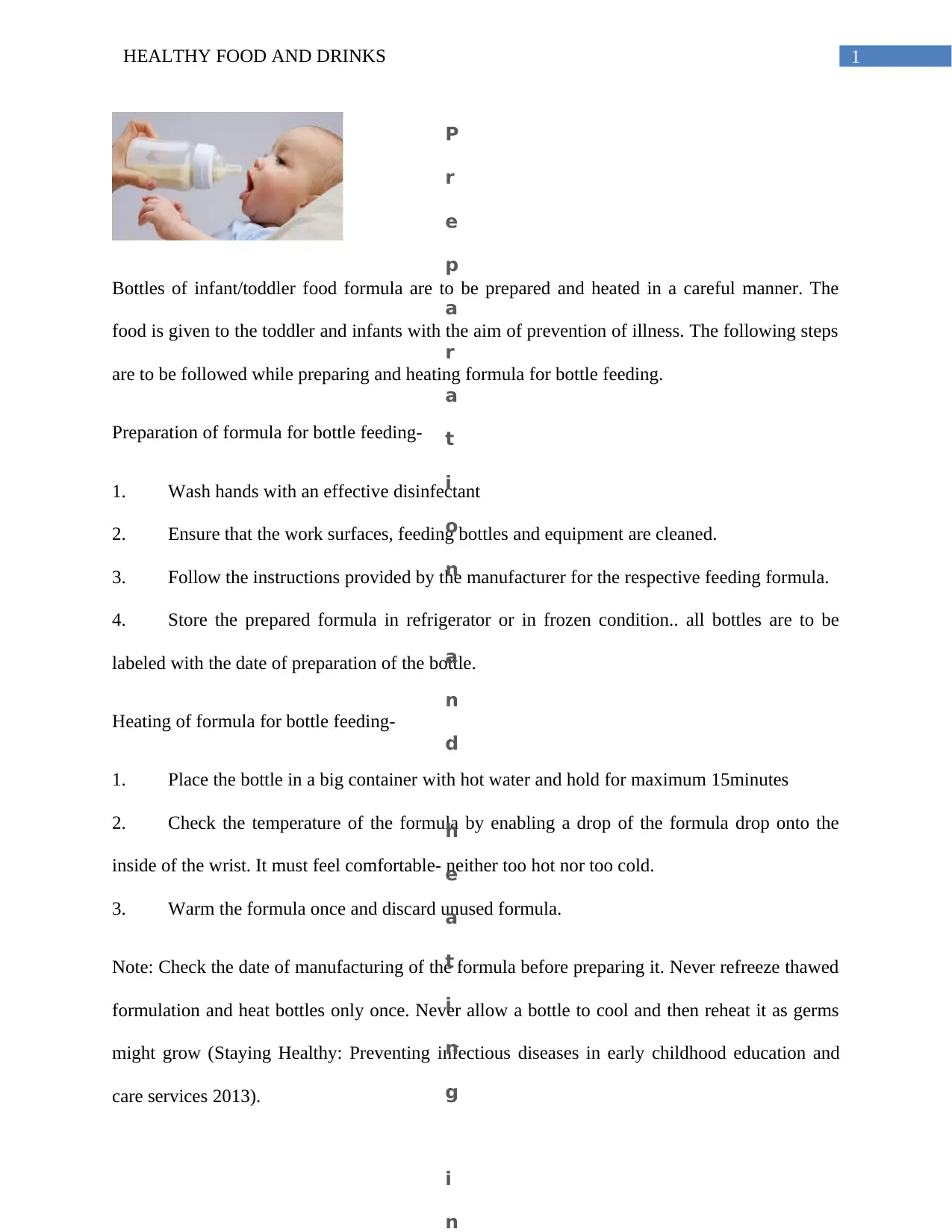
1HEALTHY FOOD AND DRINKS
Bottles of infant/toddler food formula are to be prepared and heated in a careful manner. The
food is given to the toddler and infants with the aim of prevention of illness. The following steps
are to be followed while preparing and heating formula for bottle feeding.
Preparation of formula for bottle feeding-
1. Wash hands with an effective disinfectant
2. Ensure that the work surfaces, feeding bottles and equipment are cleaned.
3. Follow the instructions provided by the manufacturer for the respective feeding formula.
4. Store the prepared formula in refrigerator or in frozen condition.. all bottles are to be
labeled with the date of preparation of the bottle.
Heating of formula for bottle feeding-
1. Place the bottle in a big container with hot water and hold for maximum 15minutes
2. Check the temperature of the formula by enabling a drop of the formula drop onto the
inside of the wrist. It must feel comfortable- neither too hot nor too cold.
3. Warm the formula once and discard unused formula.
Note: Check the date of manufacturing of the formula before preparing it. Never refreeze thawed
formulation and heat bottles only once. Never allow a bottle to cool and then reheat it as germs
might grow (Staying Healthy: Preventing infectious diseases in early childhood education and
care services 2013).
P
r
e
p
a
r
a
t
i
o
n
a
n
d
h
e
a
t
i
n
g
i
n
Bottles of infant/toddler food formula are to be prepared and heated in a careful manner. The
food is given to the toddler and infants with the aim of prevention of illness. The following steps
are to be followed while preparing and heating formula for bottle feeding.
Preparation of formula for bottle feeding-
1. Wash hands with an effective disinfectant
2. Ensure that the work surfaces, feeding bottles and equipment are cleaned.
3. Follow the instructions provided by the manufacturer for the respective feeding formula.
4. Store the prepared formula in refrigerator or in frozen condition.. all bottles are to be
labeled with the date of preparation of the bottle.
Heating of formula for bottle feeding-
1. Place the bottle in a big container with hot water and hold for maximum 15minutes
2. Check the temperature of the formula by enabling a drop of the formula drop onto the
inside of the wrist. It must feel comfortable- neither too hot nor too cold.
3. Warm the formula once and discard unused formula.
Note: Check the date of manufacturing of the formula before preparing it. Never refreeze thawed
formulation and heat bottles only once. Never allow a bottle to cool and then reheat it as germs
might grow (Staying Healthy: Preventing infectious diseases in early childhood education and
care services 2013).
P
r
e
p
a
r
a
t
i
o
n
a
n
d
h
e
a
t
i
n
g
i
n
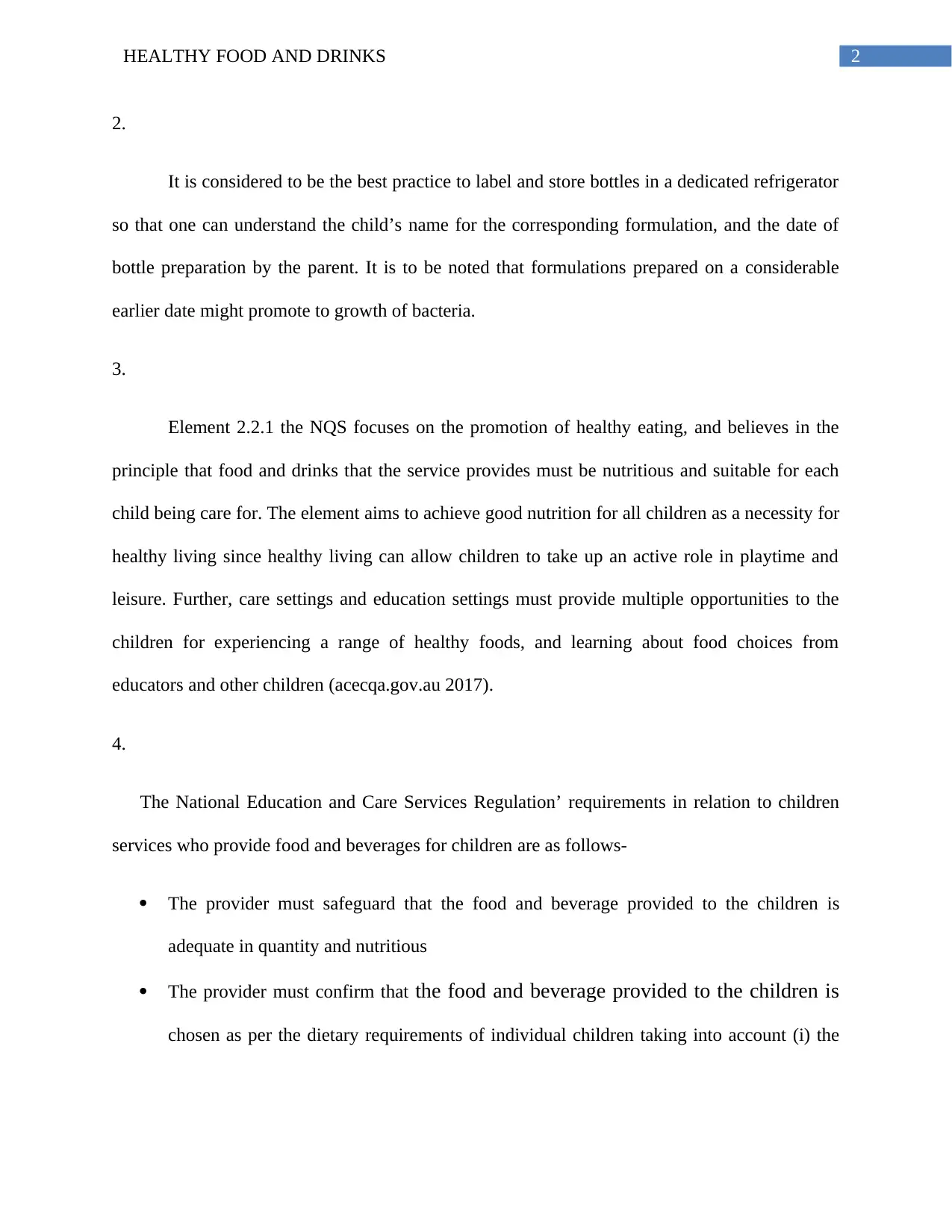
2HEALTHY FOOD AND DRINKS
2.
It is considered to be the best practice to label and store bottles in a dedicated refrigerator
so that one can understand the child’s name for the corresponding formulation, and the date of
bottle preparation by the parent. It is to be noted that formulations prepared on a considerable
earlier date might promote to growth of bacteria.
3.
Element 2.2.1 the NQS focuses on the promotion of healthy eating, and believes in the
principle that food and drinks that the service provides must be nutritious and suitable for each
child being care for. The element aims to achieve good nutrition for all children as a necessity for
healthy living since healthy living can allow children to take up an active role in playtime and
leisure. Further, care settings and education settings must provide multiple opportunities to the
children for experiencing a range of healthy foods, and learning about food choices from
educators and other children (acecqa.gov.au 2017).
4.
The National Education and Care Services Regulation’ requirements in relation to children
services who provide food and beverages for children are as follows-
The provider must safeguard that the food and beverage provided to the children is
adequate in quantity and nutritious
The provider must confirm that the food and beverage provided to the children is
chosen as per the dietary requirements of individual children taking into account (i) the
2.
It is considered to be the best practice to label and store bottles in a dedicated refrigerator
so that one can understand the child’s name for the corresponding formulation, and the date of
bottle preparation by the parent. It is to be noted that formulations prepared on a considerable
earlier date might promote to growth of bacteria.
3.
Element 2.2.1 the NQS focuses on the promotion of healthy eating, and believes in the
principle that food and drinks that the service provides must be nutritious and suitable for each
child being care for. The element aims to achieve good nutrition for all children as a necessity for
healthy living since healthy living can allow children to take up an active role in playtime and
leisure. Further, care settings and education settings must provide multiple opportunities to the
children for experiencing a range of healthy foods, and learning about food choices from
educators and other children (acecqa.gov.au 2017).
4.
The National Education and Care Services Regulation’ requirements in relation to children
services who provide food and beverages for children are as follows-
The provider must safeguard that the food and beverage provided to the children is
adequate in quantity and nutritious
The provider must confirm that the food and beverage provided to the children is
chosen as per the dietary requirements of individual children taking into account (i) the
⊘ This is a preview!⊘
Do you want full access?
Subscribe today to unlock all pages.

Trusted by 1+ million students worldwide
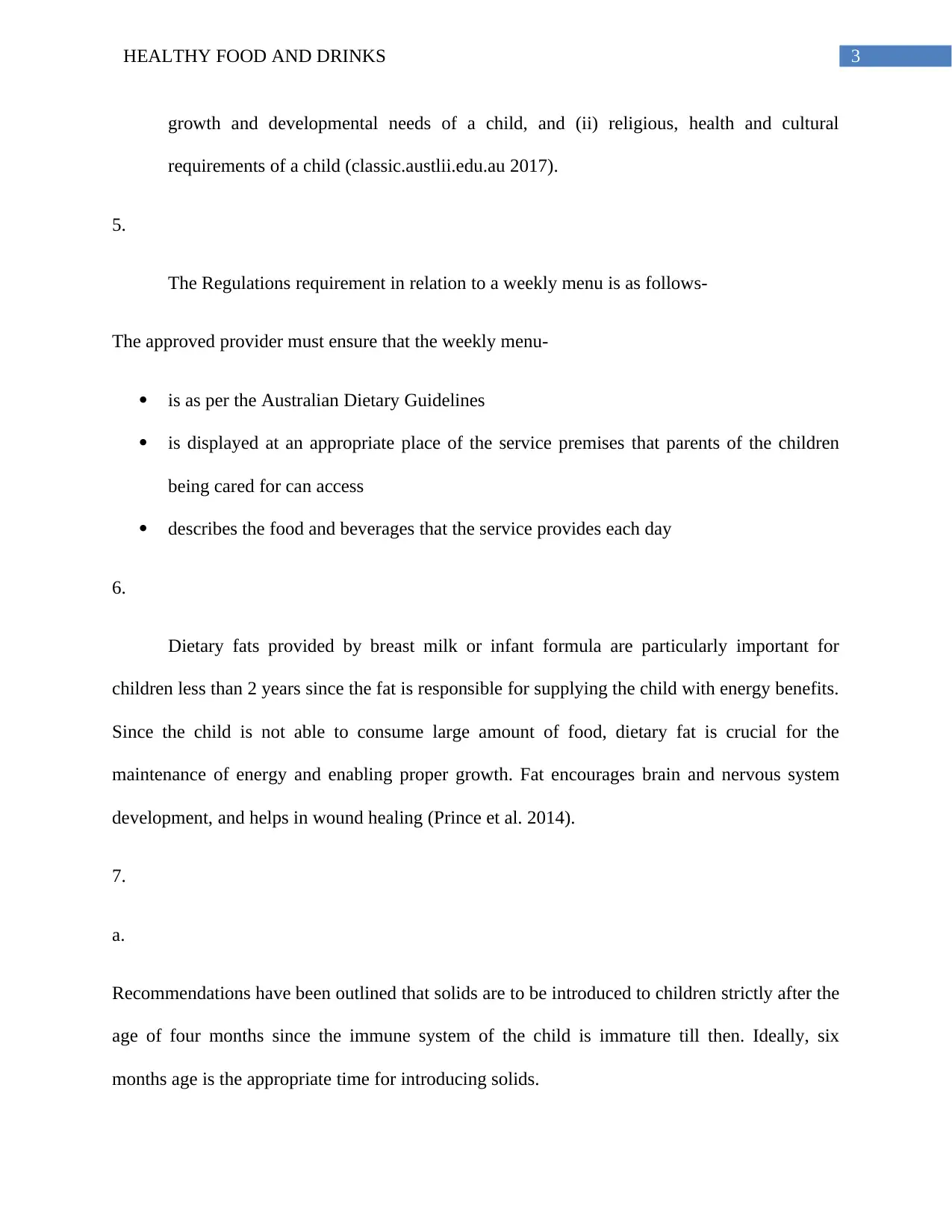
3HEALTHY FOOD AND DRINKS
growth and developmental needs of a child, and (ii) religious, health and cultural
requirements of a child (classic.austlii.edu.au 2017).
5.
The Regulations requirement in relation to a weekly menu is as follows-
The approved provider must ensure that the weekly menu-
is as per the Australian Dietary Guidelines
is displayed at an appropriate place of the service premises that parents of the children
being cared for can access
describes the food and beverages that the service provides each day
6.
Dietary fats provided by breast milk or infant formula are particularly important for
children less than 2 years since the fat is responsible for supplying the child with energy benefits.
Since the child is not able to consume large amount of food, dietary fat is crucial for the
maintenance of energy and enabling proper growth. Fat encourages brain and nervous system
development, and helps in wound healing (Prince et al. 2014).
7.
a.
Recommendations have been outlined that solids are to be introduced to children strictly after the
age of four months since the immune system of the child is immature till then. Ideally, six
months age is the appropriate time for introducing solids.
growth and developmental needs of a child, and (ii) religious, health and cultural
requirements of a child (classic.austlii.edu.au 2017).
5.
The Regulations requirement in relation to a weekly menu is as follows-
The approved provider must ensure that the weekly menu-
is as per the Australian Dietary Guidelines
is displayed at an appropriate place of the service premises that parents of the children
being cared for can access
describes the food and beverages that the service provides each day
6.
Dietary fats provided by breast milk or infant formula are particularly important for
children less than 2 years since the fat is responsible for supplying the child with energy benefits.
Since the child is not able to consume large amount of food, dietary fat is crucial for the
maintenance of energy and enabling proper growth. Fat encourages brain and nervous system
development, and helps in wound healing (Prince et al. 2014).
7.
a.
Recommendations have been outlined that solids are to be introduced to children strictly after the
age of four months since the immune system of the child is immature till then. Ideally, six
months age is the appropriate time for introducing solids.
Paraphrase This Document
Need a fresh take? Get an instant paraphrase of this document with our AI Paraphraser
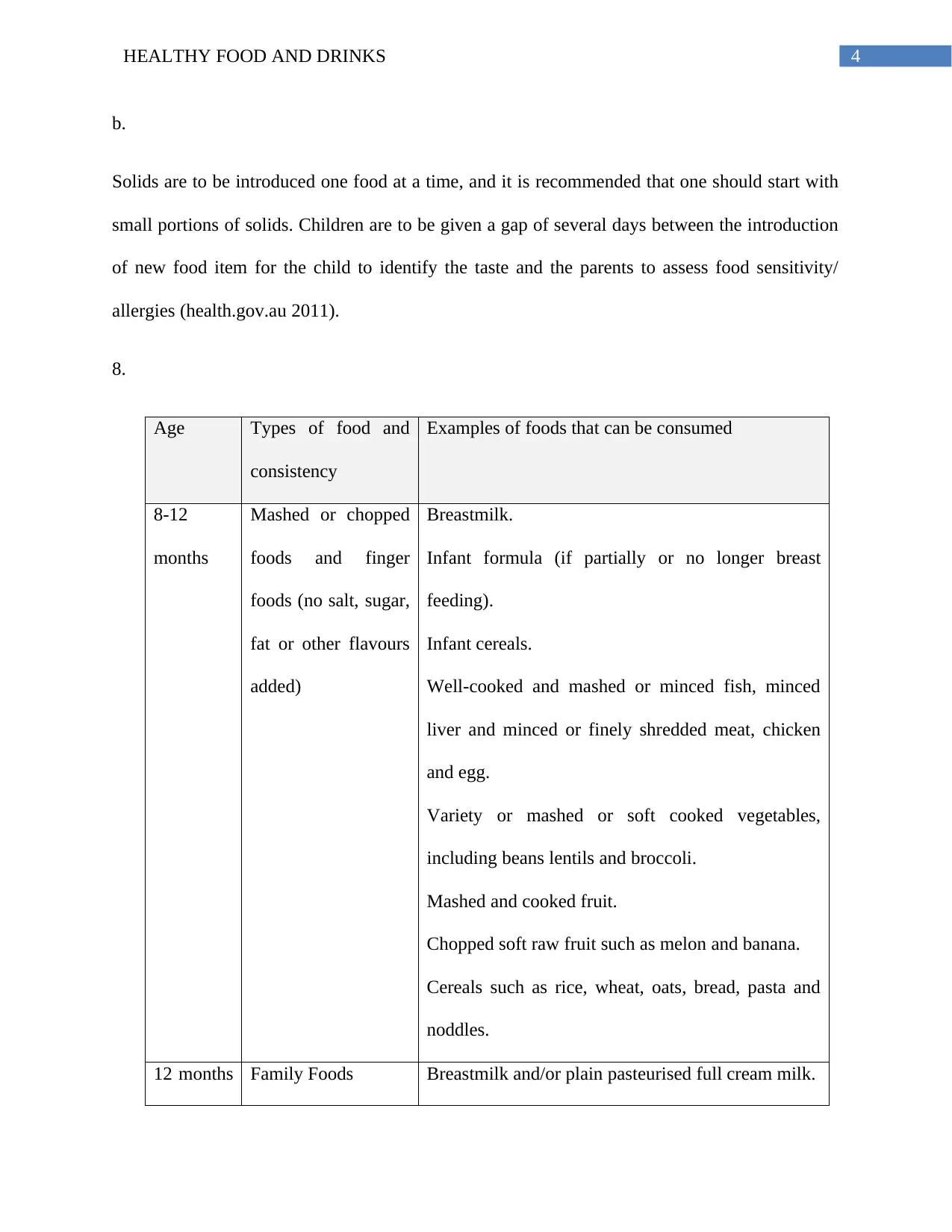
4HEALTHY FOOD AND DRINKS
b.
Solids are to be introduced one food at a time, and it is recommended that one should start with
small portions of solids. Children are to be given a gap of several days between the introduction
of new food item for the child to identify the taste and the parents to assess food sensitivity/
allergies (health.gov.au 2011).
8.
Age Types of food and
consistency
Examples of foods that can be consumed
8-12
months
Mashed or chopped
foods and finger
foods (no salt, sugar,
fat or other flavours
added)
Breastmilk.
Infant formula (if partially or no longer breast
feeding).
Infant cereals.
Well-cooked and mashed or minced fish, minced
liver and minced or finely shredded meat, chicken
and egg.
Variety or mashed or soft cooked vegetables,
including beans lentils and broccoli.
Mashed and cooked fruit.
Chopped soft raw fruit such as melon and banana.
Cereals such as rice, wheat, oats, bread, pasta and
noddles.
12 months Family Foods Breastmilk and/or plain pasteurised full cream milk.
b.
Solids are to be introduced one food at a time, and it is recommended that one should start with
small portions of solids. Children are to be given a gap of several days between the introduction
of new food item for the child to identify the taste and the parents to assess food sensitivity/
allergies (health.gov.au 2011).
8.
Age Types of food and
consistency
Examples of foods that can be consumed
8-12
months
Mashed or chopped
foods and finger
foods (no salt, sugar,
fat or other flavours
added)
Breastmilk.
Infant formula (if partially or no longer breast
feeding).
Infant cereals.
Well-cooked and mashed or minced fish, minced
liver and minced or finely shredded meat, chicken
and egg.
Variety or mashed or soft cooked vegetables,
including beans lentils and broccoli.
Mashed and cooked fruit.
Chopped soft raw fruit such as melon and banana.
Cereals such as rice, wheat, oats, bread, pasta and
noddles.
12 months Family Foods Breastmilk and/or plain pasteurised full cream milk.
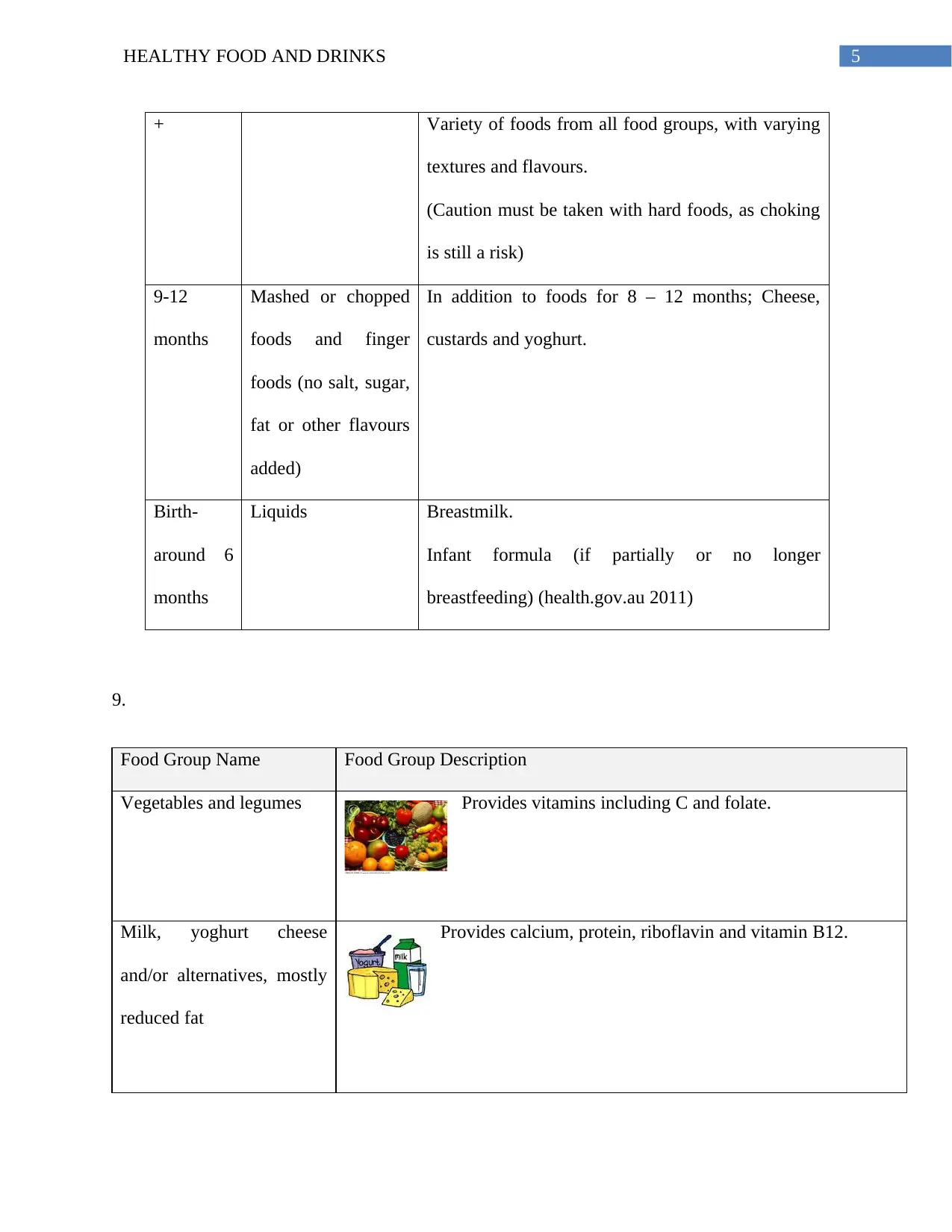
5HEALTHY FOOD AND DRINKS
+ Variety of foods from all food groups, with varying
textures and flavours.
(Caution must be taken with hard foods, as choking
is still a risk)
9-12
months
Mashed or chopped
foods and finger
foods (no salt, sugar,
fat or other flavours
added)
In addition to foods for 8 – 12 months; Cheese,
custards and yoghurt.
Birth-
around 6
months
Liquids Breastmilk.
Infant formula (if partially or no longer
breastfeeding) (health.gov.au 2011)
9.
Food Group Name Food Group Description
Vegetables and legumes Provides vitamins including C and folate.
Milk, yoghurt cheese
and/or alternatives, mostly
reduced fat
Provides calcium, protein, riboflavin and vitamin B12.
+ Variety of foods from all food groups, with varying
textures and flavours.
(Caution must be taken with hard foods, as choking
is still a risk)
9-12
months
Mashed or chopped
foods and finger
foods (no salt, sugar,
fat or other flavours
added)
In addition to foods for 8 – 12 months; Cheese,
custards and yoghurt.
Birth-
around 6
months
Liquids Breastmilk.
Infant formula (if partially or no longer
breastfeeding) (health.gov.au 2011)
9.
Food Group Name Food Group Description
Vegetables and legumes Provides vitamins including C and folate.
Milk, yoghurt cheese
and/or alternatives, mostly
reduced fat
Provides calcium, protein, riboflavin and vitamin B12.
⊘ This is a preview!⊘
Do you want full access?
Subscribe today to unlock all pages.

Trusted by 1+ million students worldwide
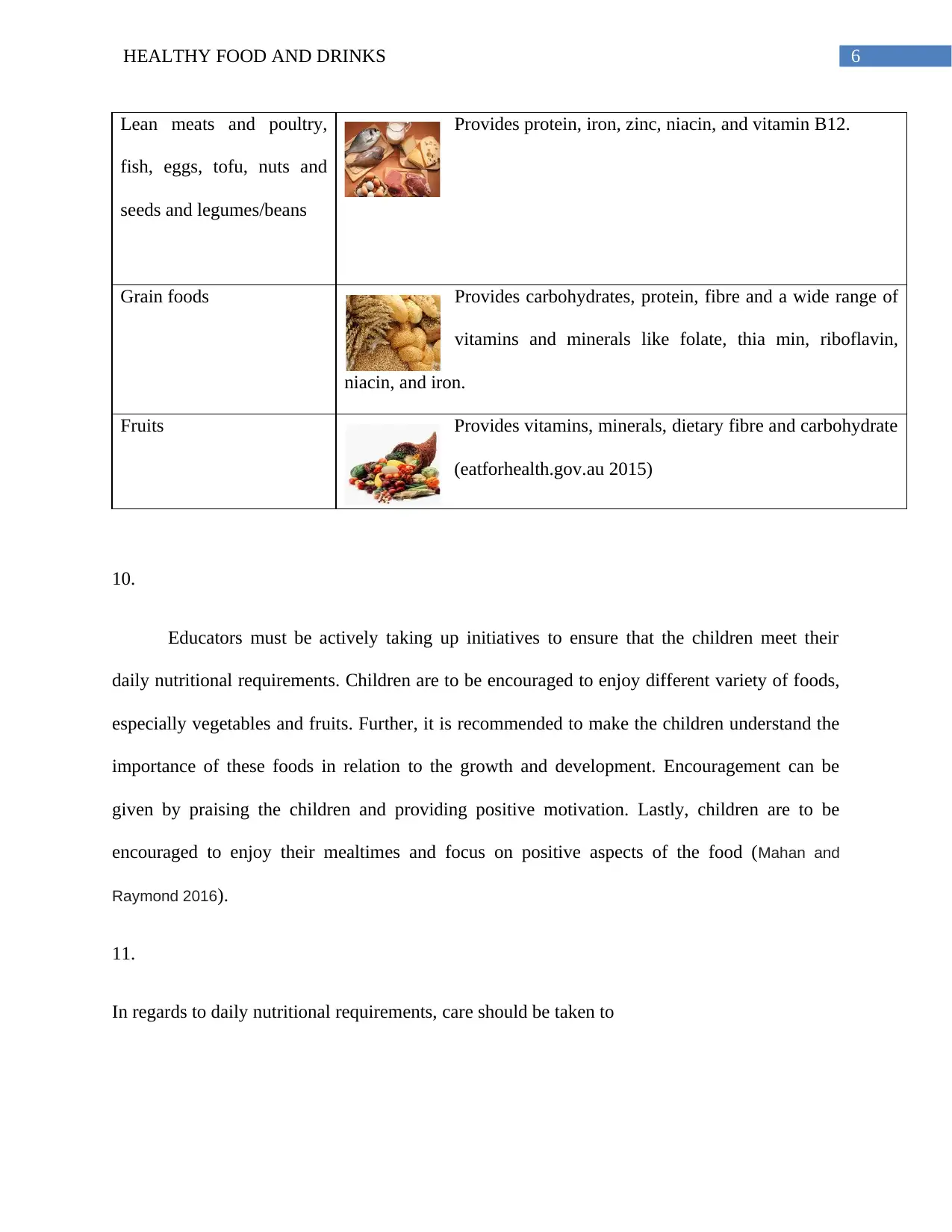
6HEALTHY FOOD AND DRINKS
Lean meats and poultry,
fish, eggs, tofu, nuts and
seeds and legumes/beans
Provides protein, iron, zinc, niacin, and vitamin B12.
Grain foods Provides carbohydrates, protein, fibre and a wide range of
vitamins and minerals like folate, thia min, riboflavin,
niacin, and iron.
Fruits Provides vitamins, minerals, dietary fibre and carbohydrate
(eatforhealth.gov.au 2015)
10.
Educators must be actively taking up initiatives to ensure that the children meet their
daily nutritional requirements. Children are to be encouraged to enjoy different variety of foods,
especially vegetables and fruits. Further, it is recommended to make the children understand the
importance of these foods in relation to the growth and development. Encouragement can be
given by praising the children and providing positive motivation. Lastly, children are to be
encouraged to enjoy their mealtimes and focus on positive aspects of the food (Mahan and
Raymond 2016).
11.
In regards to daily nutritional requirements, care should be taken to
Lean meats and poultry,
fish, eggs, tofu, nuts and
seeds and legumes/beans
Provides protein, iron, zinc, niacin, and vitamin B12.
Grain foods Provides carbohydrates, protein, fibre and a wide range of
vitamins and minerals like folate, thia min, riboflavin,
niacin, and iron.
Fruits Provides vitamins, minerals, dietary fibre and carbohydrate
(eatforhealth.gov.au 2015)
10.
Educators must be actively taking up initiatives to ensure that the children meet their
daily nutritional requirements. Children are to be encouraged to enjoy different variety of foods,
especially vegetables and fruits. Further, it is recommended to make the children understand the
importance of these foods in relation to the growth and development. Encouragement can be
given by praising the children and providing positive motivation. Lastly, children are to be
encouraged to enjoy their mealtimes and focus on positive aspects of the food (Mahan and
Raymond 2016).
11.
In regards to daily nutritional requirements, care should be taken to
Paraphrase This Document
Need a fresh take? Get an instant paraphrase of this document with our AI Paraphraser
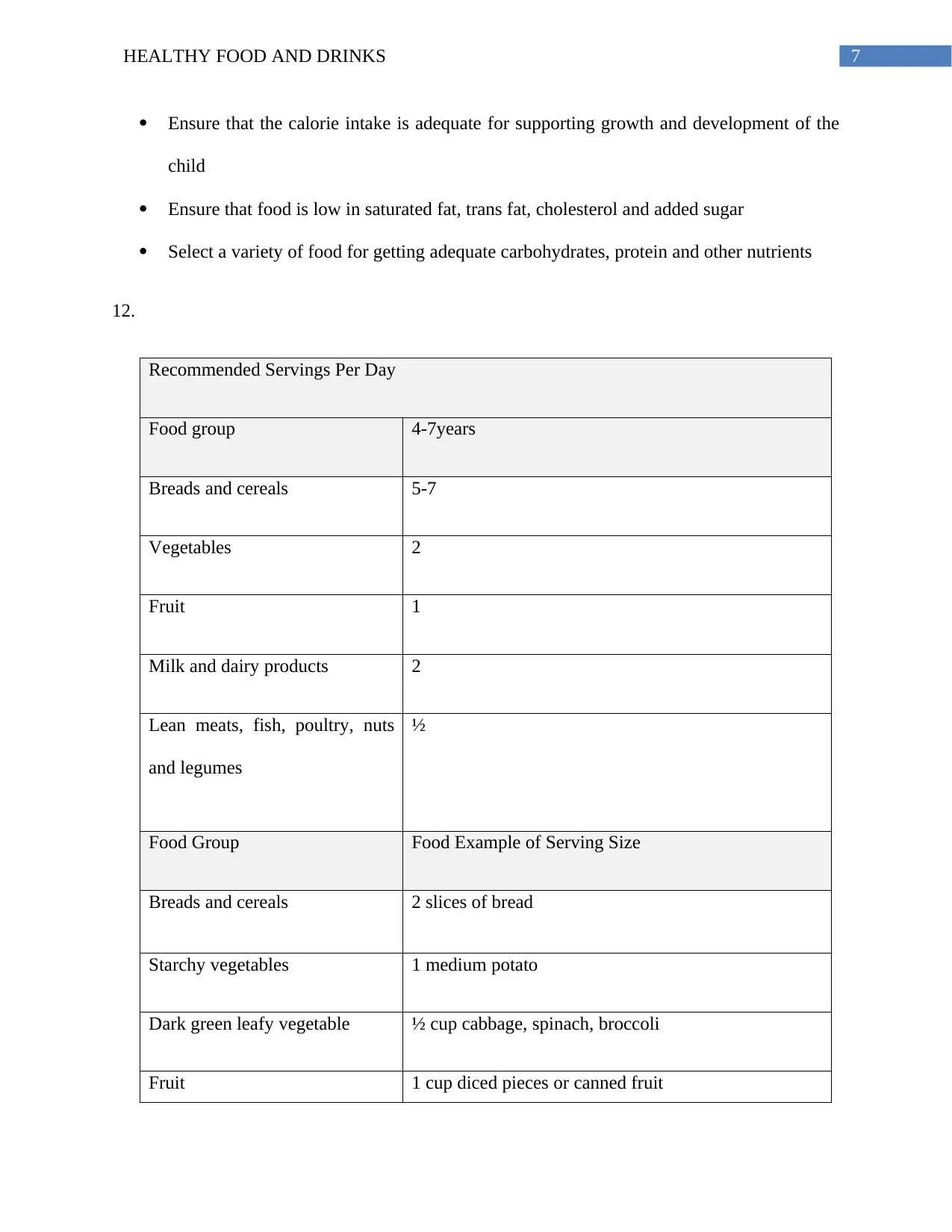
7HEALTHY FOOD AND DRINKS
Ensure that the calorie intake is adequate for supporting growth and development of the
child
Ensure that food is low in saturated fat, trans fat, cholesterol and added sugar
Select a variety of food for getting adequate carbohydrates, protein and other nutrients
12.
Recommended Servings Per Day
Food group 4-7years
Breads and cereals 5-7
Vegetables 2
Fruit 1
Milk and dairy products 2
Lean meats, fish, poultry, nuts
and legumes
½
Food Group Food Example of Serving Size
Breads and cereals 2 slices of bread
Starchy vegetables 1 medium potato
Dark green leafy vegetable ½ cup cabbage, spinach, broccoli
Fruit 1 cup diced pieces or canned fruit
Ensure that the calorie intake is adequate for supporting growth and development of the
child
Ensure that food is low in saturated fat, trans fat, cholesterol and added sugar
Select a variety of food for getting adequate carbohydrates, protein and other nutrients
12.
Recommended Servings Per Day
Food group 4-7years
Breads and cereals 5-7
Vegetables 2
Fruit 1
Milk and dairy products 2
Lean meats, fish, poultry, nuts
and legumes
½
Food Group Food Example of Serving Size
Breads and cereals 2 slices of bread
Starchy vegetables 1 medium potato
Dark green leafy vegetable ½ cup cabbage, spinach, broccoli
Fruit 1 cup diced pieces or canned fruit
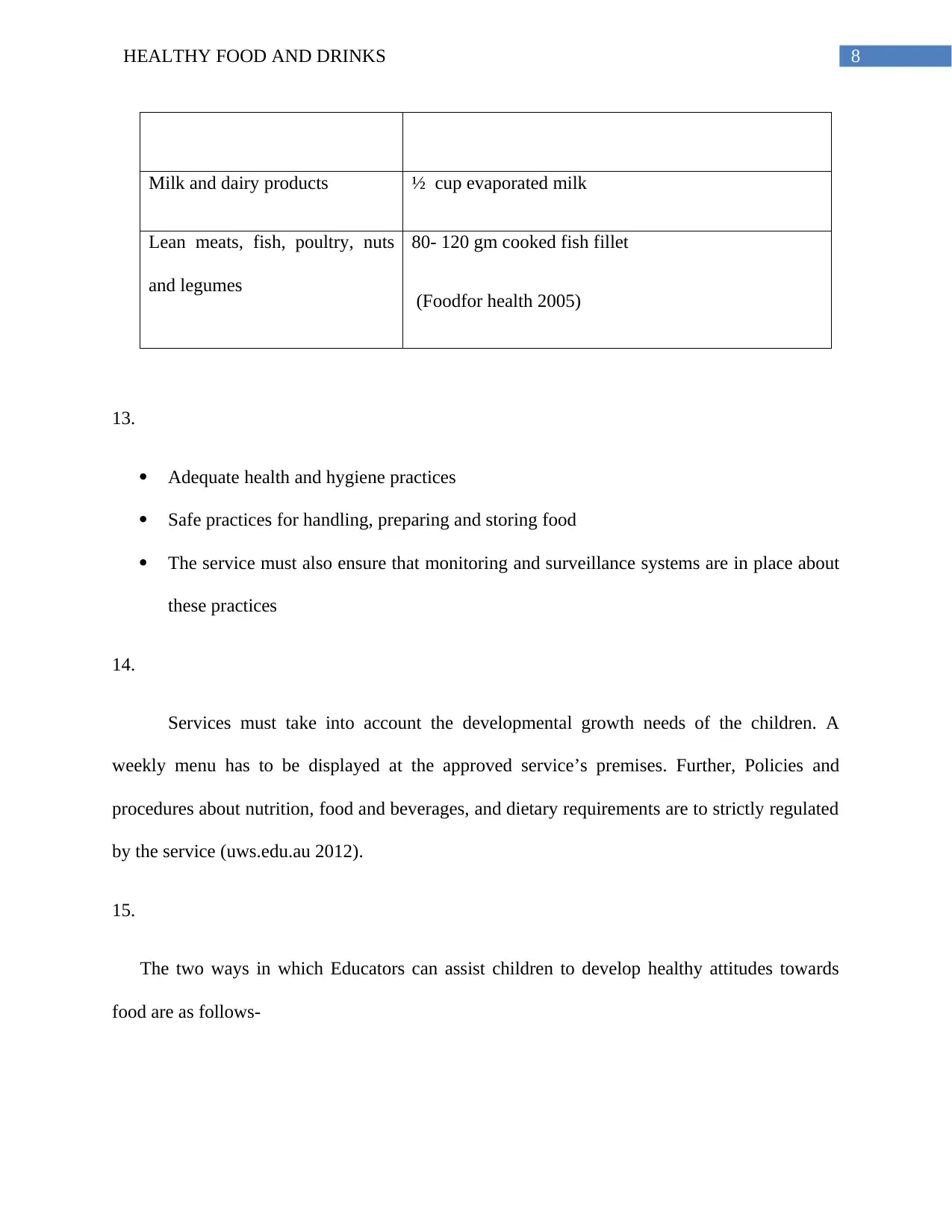
8HEALTHY FOOD AND DRINKS
Milk and dairy products ½ cup evaporated milk
Lean meats, fish, poultry, nuts
and legumes
80- 120 gm cooked fish fillet
(Foodfor health 2005)
13.
Adequate health and hygiene practices
Safe practices for handling, preparing and storing food
The service must also ensure that monitoring and surveillance systems are in place about
these practices
14.
Services must take into account the developmental growth needs of the children. A
weekly menu has to be displayed at the approved service’s premises. Further, Policies and
procedures about nutrition, food and beverages, and dietary requirements are to strictly regulated
by the service (uws.edu.au 2012).
15.
The two ways in which Educators can assist children to develop healthy attitudes towards
food are as follows-
Milk and dairy products ½ cup evaporated milk
Lean meats, fish, poultry, nuts
and legumes
80- 120 gm cooked fish fillet
(Foodfor health 2005)
13.
Adequate health and hygiene practices
Safe practices for handling, preparing and storing food
The service must also ensure that monitoring and surveillance systems are in place about
these practices
14.
Services must take into account the developmental growth needs of the children. A
weekly menu has to be displayed at the approved service’s premises. Further, Policies and
procedures about nutrition, food and beverages, and dietary requirements are to strictly regulated
by the service (uws.edu.au 2012).
15.
The two ways in which Educators can assist children to develop healthy attitudes towards
food are as follows-
⊘ This is a preview!⊘
Do you want full access?
Subscribe today to unlock all pages.

Trusted by 1+ million students worldwide
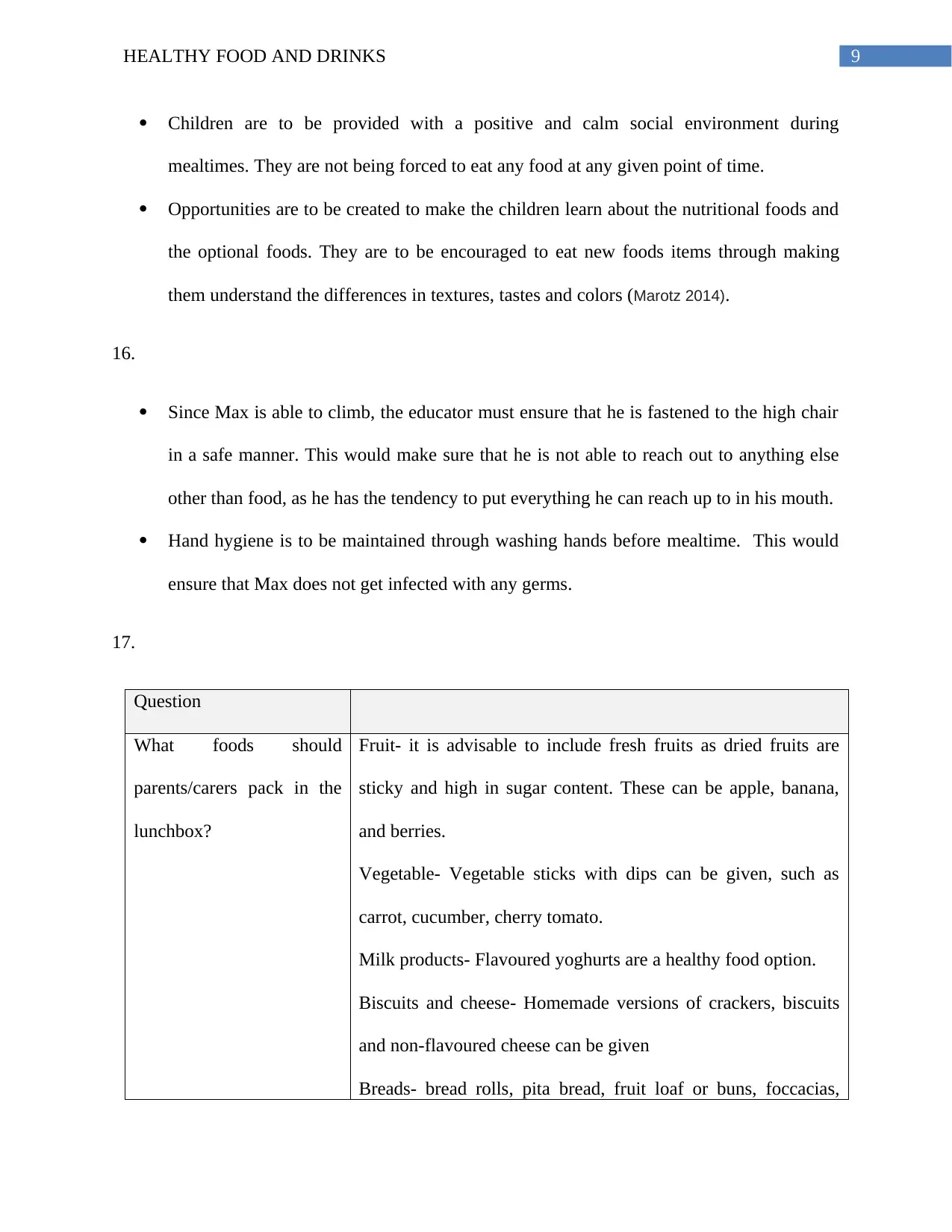
9HEALTHY FOOD AND DRINKS
Children are to be provided with a positive and calm social environment during
mealtimes. They are not being forced to eat any food at any given point of time.
Opportunities are to be created to make the children learn about the nutritional foods and
the optional foods. They are to be encouraged to eat new foods items through making
them understand the differences in textures, tastes and colors (Marotz 2014).
16.
Since Max is able to climb, the educator must ensure that he is fastened to the high chair
in a safe manner. This would make sure that he is not able to reach out to anything else
other than food, as he has the tendency to put everything he can reach up to in his mouth.
Hand hygiene is to be maintained through washing hands before mealtime. This would
ensure that Max does not get infected with any germs.
17.
Question
What foods should
parents/carers pack in the
lunchbox?
Fruit- it is advisable to include fresh fruits as dried fruits are
sticky and high in sugar content. These can be apple, banana,
and berries.
Vegetable- Vegetable sticks with dips can be given, such as
carrot, cucumber, cherry tomato.
Milk products- Flavoured yoghurts are a healthy food option.
Biscuits and cheese- Homemade versions of crackers, biscuits
and non-flavoured cheese can be given
Breads- bread rolls, pita bread, fruit loaf or buns, foccacias,
Children are to be provided with a positive and calm social environment during
mealtimes. They are not being forced to eat any food at any given point of time.
Opportunities are to be created to make the children learn about the nutritional foods and
the optional foods. They are to be encouraged to eat new foods items through making
them understand the differences in textures, tastes and colors (Marotz 2014).
16.
Since Max is able to climb, the educator must ensure that he is fastened to the high chair
in a safe manner. This would make sure that he is not able to reach out to anything else
other than food, as he has the tendency to put everything he can reach up to in his mouth.
Hand hygiene is to be maintained through washing hands before mealtime. This would
ensure that Max does not get infected with any germs.
17.
Question
What foods should
parents/carers pack in the
lunchbox?
Fruit- it is advisable to include fresh fruits as dried fruits are
sticky and high in sugar content. These can be apple, banana,
and berries.
Vegetable- Vegetable sticks with dips can be given, such as
carrot, cucumber, cherry tomato.
Milk products- Flavoured yoghurts are a healthy food option.
Biscuits and cheese- Homemade versions of crackers, biscuits
and non-flavoured cheese can be given
Breads- bread rolls, pita bread, fruit loaf or buns, foccacias,
Paraphrase This Document
Need a fresh take? Get an instant paraphrase of this document with our AI Paraphraser
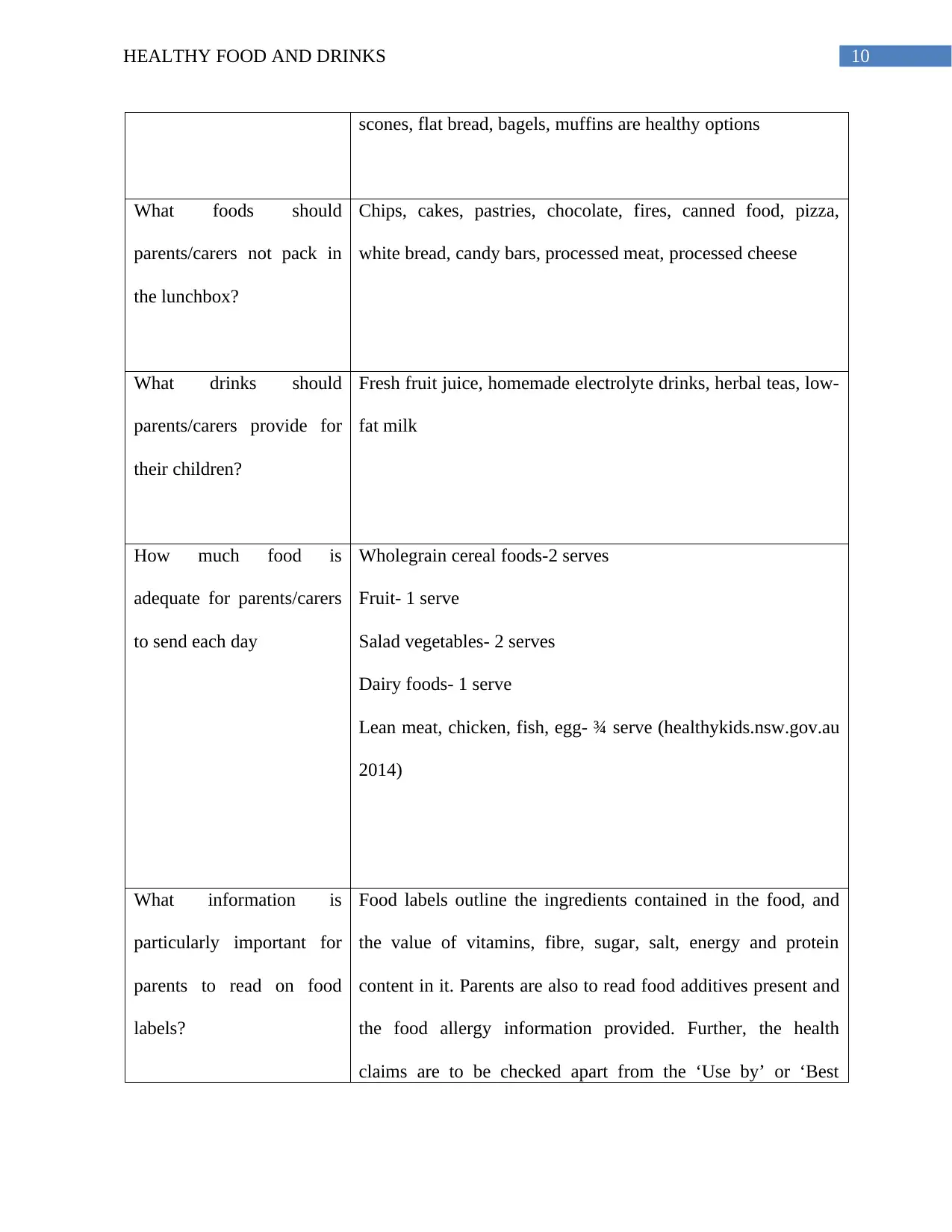
10HEALTHY FOOD AND DRINKS
scones, flat bread, bagels, muffins are healthy options
What foods should
parents/carers not pack in
the lunchbox?
Chips, cakes, pastries, chocolate, fires, canned food, pizza,
white bread, candy bars, processed meat, processed cheese
What drinks should
parents/carers provide for
their children?
Fresh fruit juice, homemade electrolyte drinks, herbal teas, low-
fat milk
How much food is
adequate for parents/carers
to send each day
Wholegrain cereal foods-2 serves
Fruit- 1 serve
Salad vegetables- 2 serves
Dairy foods- 1 serve
Lean meat, chicken, fish, egg- ¾ serve (healthykids.nsw.gov.au
2014)
What information is
particularly important for
parents to read on food
labels?
Food labels outline the ingredients contained in the food, and
the value of vitamins, fibre, sugar, salt, energy and protein
content in it. Parents are also to read food additives present and
the food allergy information provided. Further, the health
claims are to be checked apart from the ‘Use by’ or ‘Best
scones, flat bread, bagels, muffins are healthy options
What foods should
parents/carers not pack in
the lunchbox?
Chips, cakes, pastries, chocolate, fires, canned food, pizza,
white bread, candy bars, processed meat, processed cheese
What drinks should
parents/carers provide for
their children?
Fresh fruit juice, homemade electrolyte drinks, herbal teas, low-
fat milk
How much food is
adequate for parents/carers
to send each day
Wholegrain cereal foods-2 serves
Fruit- 1 serve
Salad vegetables- 2 serves
Dairy foods- 1 serve
Lean meat, chicken, fish, egg- ¾ serve (healthykids.nsw.gov.au
2014)
What information is
particularly important for
parents to read on food
labels?
Food labels outline the ingredients contained in the food, and
the value of vitamins, fibre, sugar, salt, energy and protein
content in it. Parents are also to read food additives present and
the food allergy information provided. Further, the health
claims are to be checked apart from the ‘Use by’ or ‘Best
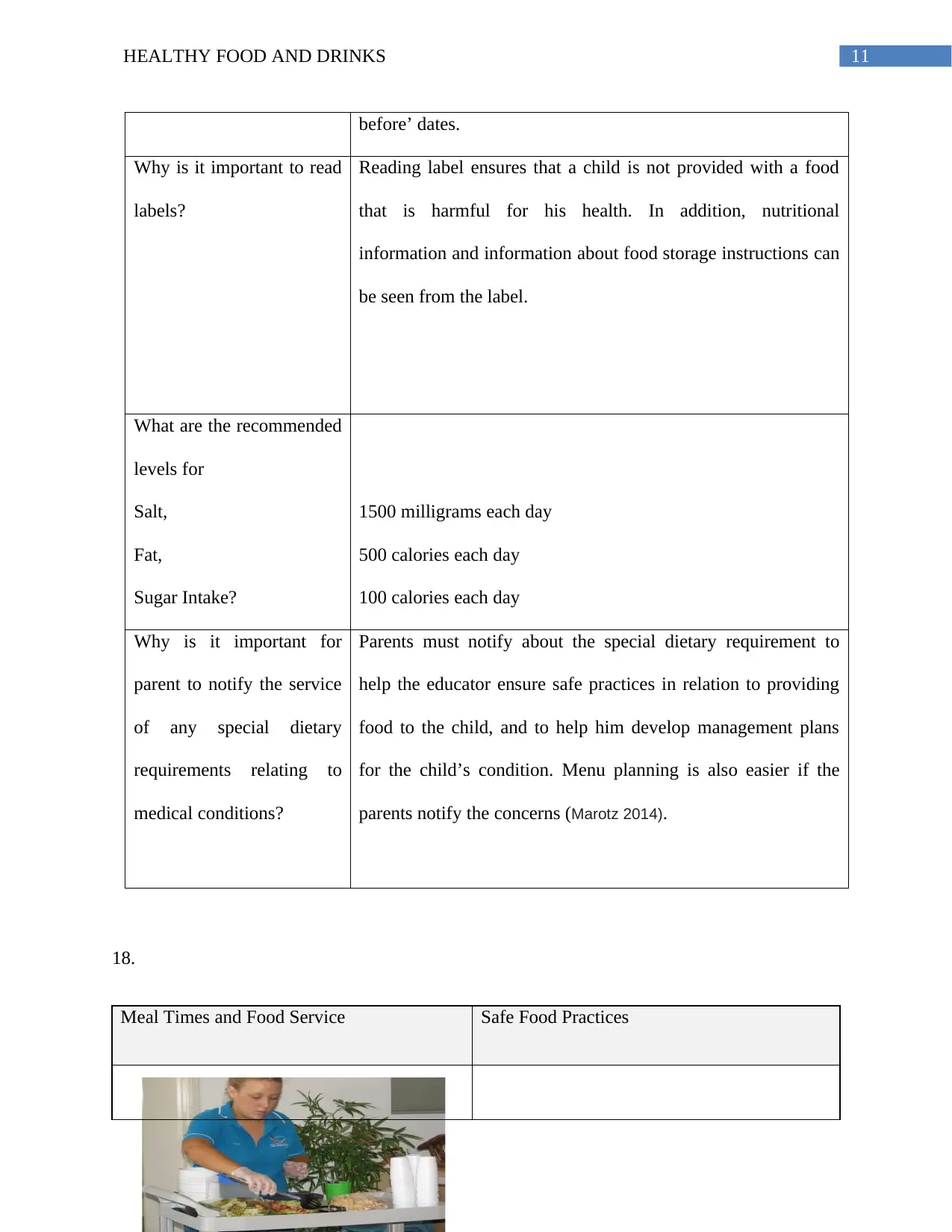
11HEALTHY FOOD AND DRINKS
before’ dates.
Why is it important to read
labels?
Reading label ensures that a child is not provided with a food
that is harmful for his health. In addition, nutritional
information and information about food storage instructions can
be seen from the label.
What are the recommended
levels for
Salt,
Fat,
Sugar Intake?
1500 milligrams each day
500 calories each day
100 calories each day
Why is it important for
parent to notify the service
of any special dietary
requirements relating to
medical conditions?
Parents must notify about the special dietary requirement to
help the educator ensure safe practices in relation to providing
food to the child, and to help him develop management plans
for the child’s condition. Menu planning is also easier if the
parents notify the concerns (Marotz 2014).
18.
Meal Times and Food Service Safe Food Practices
before’ dates.
Why is it important to read
labels?
Reading label ensures that a child is not provided with a food
that is harmful for his health. In addition, nutritional
information and information about food storage instructions can
be seen from the label.
What are the recommended
levels for
Salt,
Fat,
Sugar Intake?
1500 milligrams each day
500 calories each day
100 calories each day
Why is it important for
parent to notify the service
of any special dietary
requirements relating to
medical conditions?
Parents must notify about the special dietary requirement to
help the educator ensure safe practices in relation to providing
food to the child, and to help him develop management plans
for the child’s condition. Menu planning is also easier if the
parents notify the concerns (Marotz 2014).
18.
Meal Times and Food Service Safe Food Practices
⊘ This is a preview!⊘
Do you want full access?
Subscribe today to unlock all pages.

Trusted by 1+ million students worldwide
1 out of 24
Related Documents
Your All-in-One AI-Powered Toolkit for Academic Success.
+13062052269
info@desklib.com
Available 24*7 on WhatsApp / Email
![[object Object]](/_next/static/media/star-bottom.7253800d.svg)
Unlock your academic potential
Copyright © 2020–2025 A2Z Services. All Rights Reserved. Developed and managed by ZUCOL.



